Build a process around asking people to do something that’s only slightly more difficult than what they did previously, and you have a successful digital organizing strategy.
The “frog in boiling water” serves as an example.
Everyone knows the story: a group of scientists put a frog in boiling water and it immediately jumps out. But when they put it in cold water and slowly raise the temperature, the frog meets its demise.
The story is often held up as a metaphor for the slow erosion of social values. But this is already a sombre time and I choose to look at the silver lining.
It tells us that if you ask for a small enough change in behavior, people are more likely to take that action. The smaller the friction, the higher the conversion. And over time you get folks to take actions, they wouldn’t have agreed to in the beginning.
As Hester Leyser, Mobilization Director for MJ Hegar for US Senate puts it “Suddenly you’ve got somebody doing really incredible work for you all the time even if they initially only just followed you on Twitter.”


It can feel frustrating to not be able to persuade folks over a face to face conversation. And with landline lists shrinking every day, maintaining personal relationships is a continuous struggle.
On the other side, social channels are seeing a huge influx of traffic that isn’t translating into meaningful actions.
And organizers have to deal with all of this while juggling multiple tools that behave like a dysfunctional couple that won’t talk to each other.
I want to touch on these issues and look at how digital organizing tools, volunteer recruitment, virtual events, phone banks, and texts banks all tie together to create a digital organizing strategy that’s larger than the sum of its parts.
What is digital organizing?
Digital organizing uses virtual tools to move passive citizens (eg. social media followers) into active stakeholders in your organization (eg. phone bank host) who take meaningful actions towards electoral change.
The ladder of engagement is an organizing framework that is designed around this approach to develop supporters into volunteers and volunteers into invested stakeholders over a series of steps that are only slightly more difficult than the previous one.
The digital engagement tactics in the ladder of engagement span across three areas:
- Identification (and recruitment)
- Engagement
- Activation of supporters.
| The ladder of engagement framework | Identifying and recruiting supporters | Engaging supporters | Activating supporters to become stakeholders |
| What is it? | Finds people in your target geography who can potentially be engaged to become involved with your organization. | Identified supporters are consistently engaged in organizational activities. You’ll find groups with multiple levels of interest, some moving more quickly up the ladder of engagement than others. | Moving engaged supporters to higher barrier actions that create impact at the ballot. For an invested supporter, that might be a self-hosted phone banking party. For the majority of supporters, that could be a relational organizing app they download to regularly share campaign actions with friends and family. |
| Who is the target audience? | • social media followers• friends and family members of existing supporters• folks with interests that align with causes your organization is championing• state voter lists | • website signups• First-time volunteers• People signing up for events• Contacts collected through relational organizing efforts | • Regular phone, text and field volunteers• Engaged friends and family members of existing supporters• Regular event attendees• Others who indicated strong support |
| What is the goal? | Identifying new supporters and building a list with their details. | Build long-term relationships with identified supporters. | Move engaged supporters to take meaningful actions towards electoral change. |
| Ready to revolutionize the way you organize online? See how Relational Organizing will help you build real connections and drive results. |
The ladder of engagement in action
The ladder of engagement for the MJ Hegar for US Senate campaign looks like this:
Step 1: Supporter clicks on a link on Twitter and registers on the campaign website.
Step 2: Campaign makes an ask to join a volunteer training call.
Step 3: Attendees are asked to join a phone banking shift.
Step 4: Volunteers who attend the shift are asked to commit to a regular weekly phone banking shift.
Step 5: Regular volunteers are asked to help train new volunteers.
Step 6: Super-volunteers who’ve been helping with training are asked to lead their own training.
Identifying and recruiting potential supporters
Using owned media
“Go where your people are. Don’t go where you think people have to be online,”
– Stefan Smith, Online Engagement Director for Pete Buttigieg
Don’t go to Snapchat and Tiktok because you want to target Gen Z. Don’t go to Twitter because that’s where ‘the influencers’ are.
Find out where your audience hangs out.
That may be on Pinterest, subreddits, or closed Facebook groups. Find those spaces, build your presence, and create opportunities for people to join you.
Motivate folks to share their email, phone number, and zip code through different creative asks.
MJ Hegar campaign collects supporter details by asking them to pledge to vote.
Allison Fine motivates visitors who click through to the campaign website to share their details by inviting them to a “virtual living room conversation”.
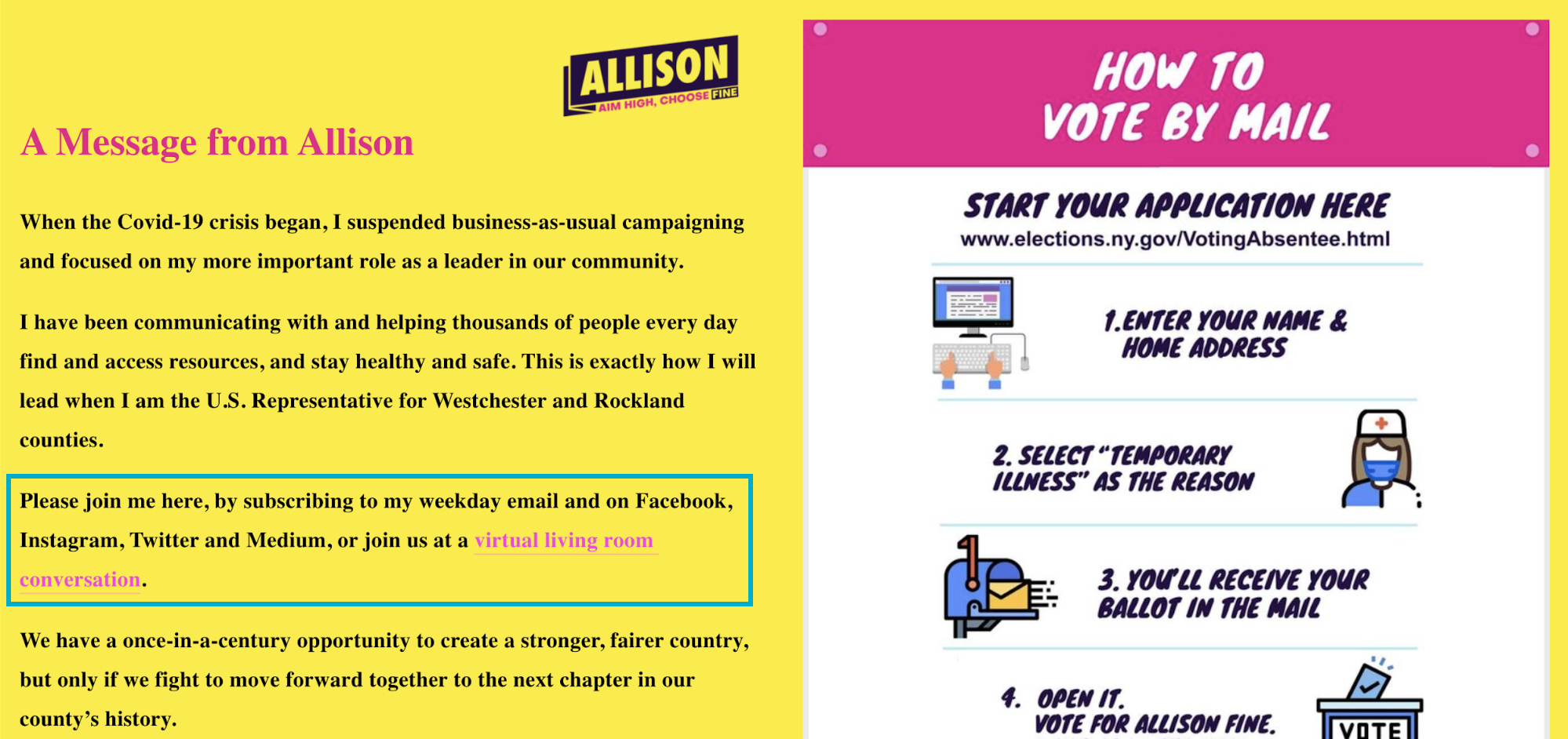

The objective behind both asks is to identify and recruit supporters.
However, they target audiences across different levels of engagement.
While a less committed supporter might be open to pledging a vote, a strong supporter would be happy to join a live event. The idea is to be as flexible as you can with your asks to appeal to a diverse audience.


Flake rates are going to be high for new signups. Email and SMS reminders make sure that people who sign up follow through on their commitment.
For example, sending out a personal SMS before an event can boost attendance by serving as a helpful reminder and making supporters feel valued.
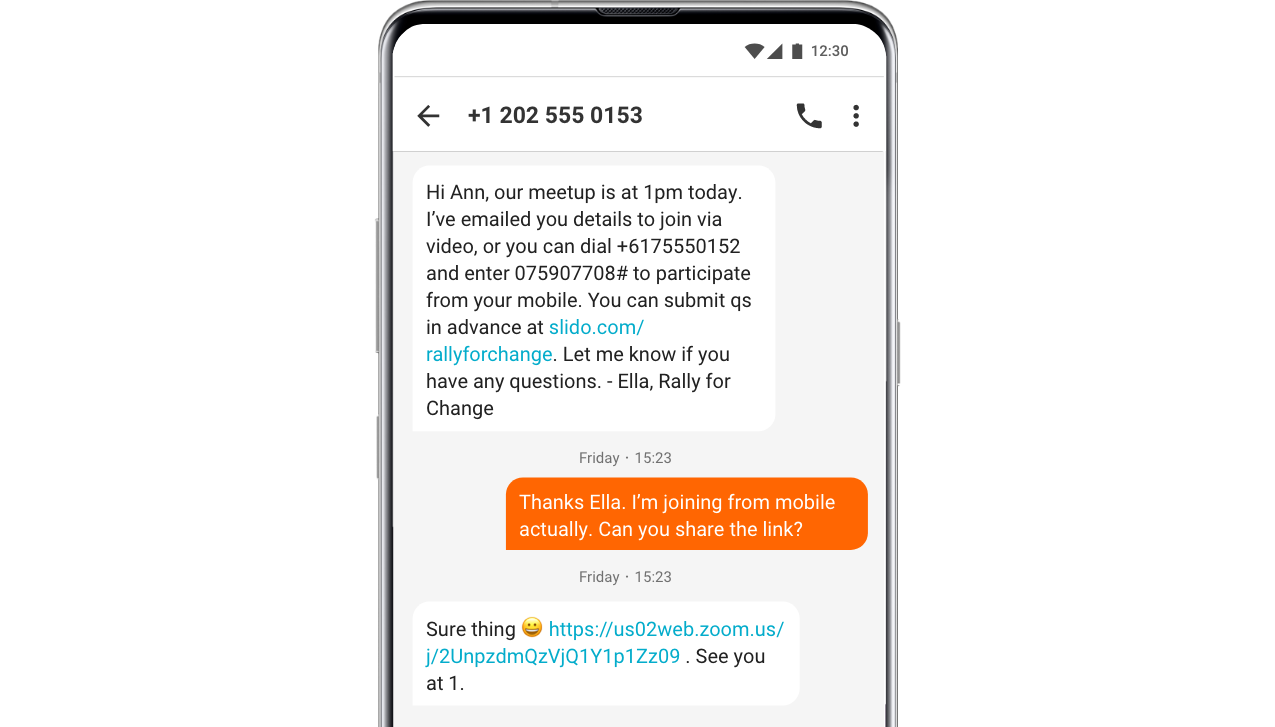

If you have the capacity, send a personal nudge using peer to peer texts, but if you’re pressed for volunteers and time, a broadcast SMS will still work.
To avoid the hassle of shuffling contacts between multiple tools, populate your tech stack with digital tools that work well with each other.
For example. Allison Fine’s “virtual living room conversation” is set up on Action Network.


Connecting CallHub to Action Network lets you add new signups directly to a peer to peer texting or SMS broadcast campaign without exporting and importing spreadsheets.


Once you get folks to attend a call, make the slightly more difficult request for them to sign up for a volunteer shift. Some of them have the potential to become volunteer leaders who can take up leadership roles in your organization.
And it’s also okay that most folks will be too busy to volunteer their time. Keep them in the loop with webinars, town halls, community-building calls, and live events, and smaller actions like signing petitions.
Use paid channels to identify supporters
Digital Ad Buying
Search, social, and display ads help you get in front of new audiences. While larger nonprofits tend to split their spending between Display ads (35%) and Social Media ads (54%), for smaller nonprofits that ratio is currently skewed towards Social Media (96%).
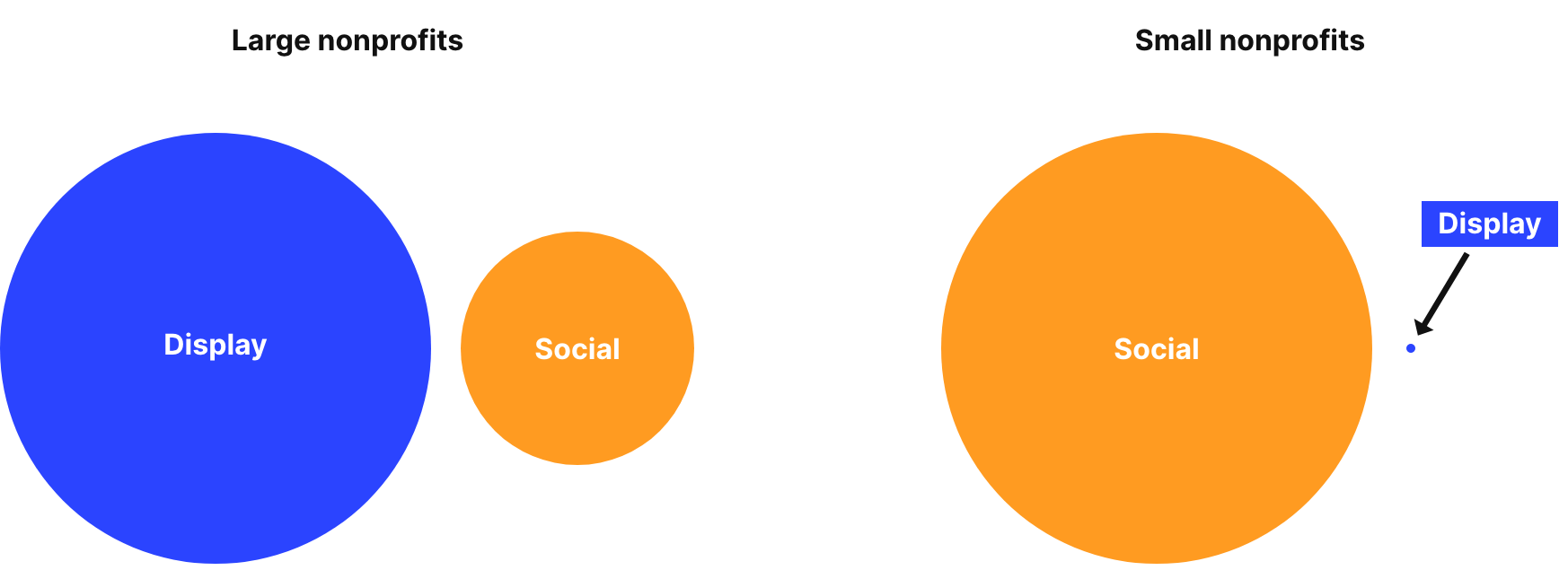

Like it or not, with organic reach on Facebook standing at around 6%, it’s a given that you have to invest in social media advertising.
But keep a portion of your budget for display and search ads.
Display ads, in the form of view-through revenue, accounted for 43% of digital ad giving in 2019.
View-through revenue: View-through conversions occur after a user sees an ad but doesn’t interact with it. And then later donates. The average conversion window is around 30 days.
Search ads bring in the highest return on ad spend at $3.59 compared to Display Ads ($0.74) and Social Media Ads ($0.70).
Focus on accurate targeting and optimized website experience to maximize returns on ad spends:
Accurate targeting
Without tools to guide spending on digital, it’s hard to make sure you are speaking to the
right people, saying the right thing and doing it through the right channels.
If you’re creating custom audiences, data vendors like L2Political, TargetSmart, and Aristotle can help you procure targeted lists or append existing lists with more data points.
Tools like Civis Analytics and DSPolitical help specifically with ad targeting and testing, giving you detailed insights on the messaging or tactics that work for specific audiences, from national to specific congressional districts.
Conversion-optimized landing pages


Your landing page is the first thing visitors see when they click through from an ad. Make sure landing pages make it as easy as possible for visitors to take the intended action, whether it’s to learn more about a particular issue or to sign up to volunteer. The example above compares the Search Engine Results Pages (SERP) for volunteering opportunities with MJ Hegar and Royce West.
The page on the left clearly conveys the goal of the campaign and why they need volunteers, alongside a large legible form. Visitors landing on the page on the right have to scroll down and click-through to another page before they can sign-up. The lower the friction for visitors, the higher your conversion rates are going to be.
Suggested reading:
1. How to set up your Election Campaign website
2. Mastering the Art of Community Organizing: 6 Essential Steps for Success
3. Community Organizing: Important strategies to keep in Mind
4. Step by step guide to building a great nonprofit website (with examples for inspiration)
Creative examples of Digital Organizing for inspiration
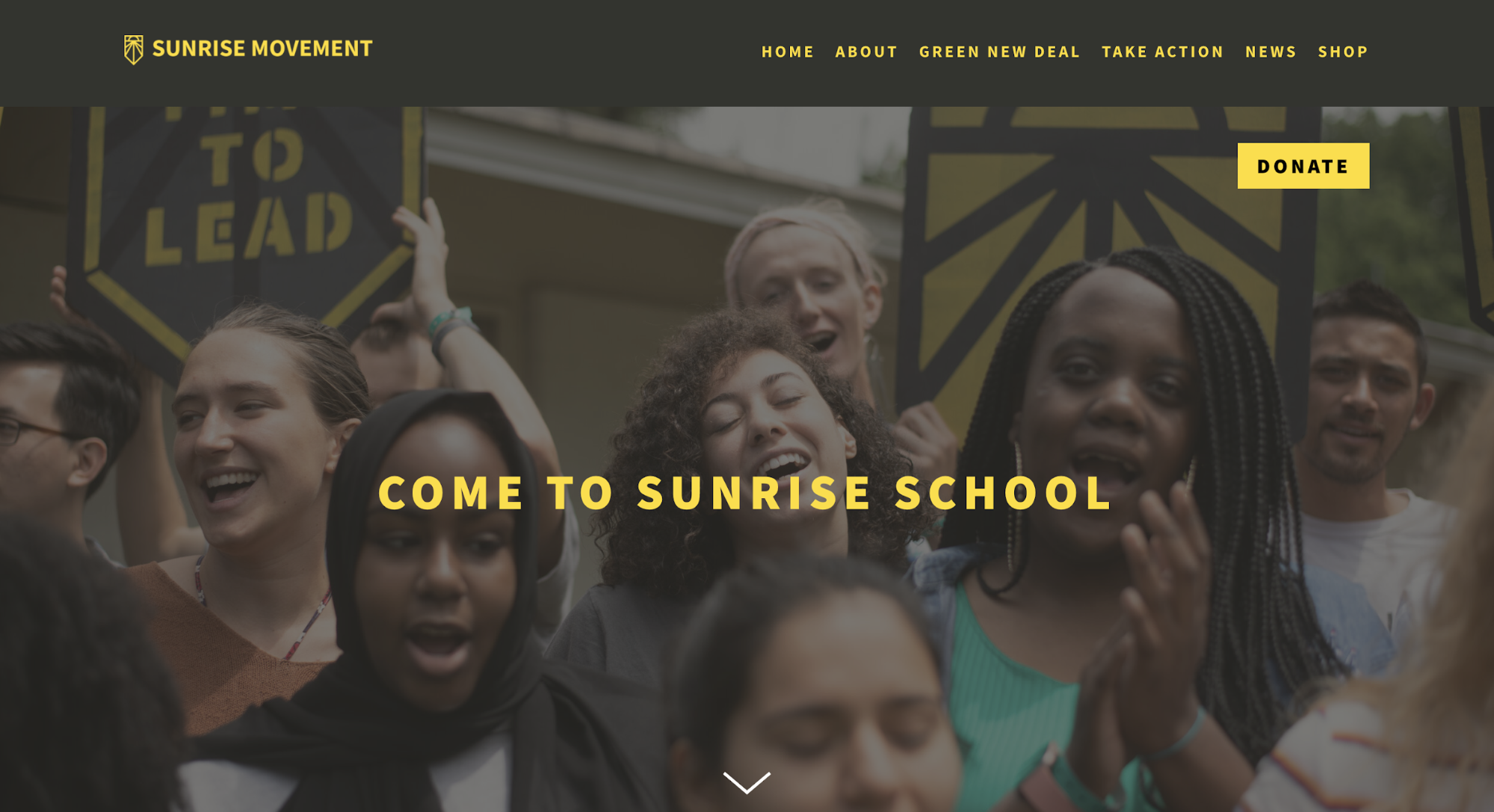

Sunrise School
Sunrise Movement, an early champion of the Green New Deal launched the “Sunrise School”, a digital organizing training program where supporters across the country can apply to learn skills ranging from visual art, video production, and graphic design as tools for organizing. Sunrise Movement understood the pulse of their audience and created a way for them to channel their energies into something productive and positive during a pandemic. Goes to show why a program that organizers expected to bring in around 600 participants got interested from more than 3500 people
Here are 5 more organizations conducting digital organizing training:
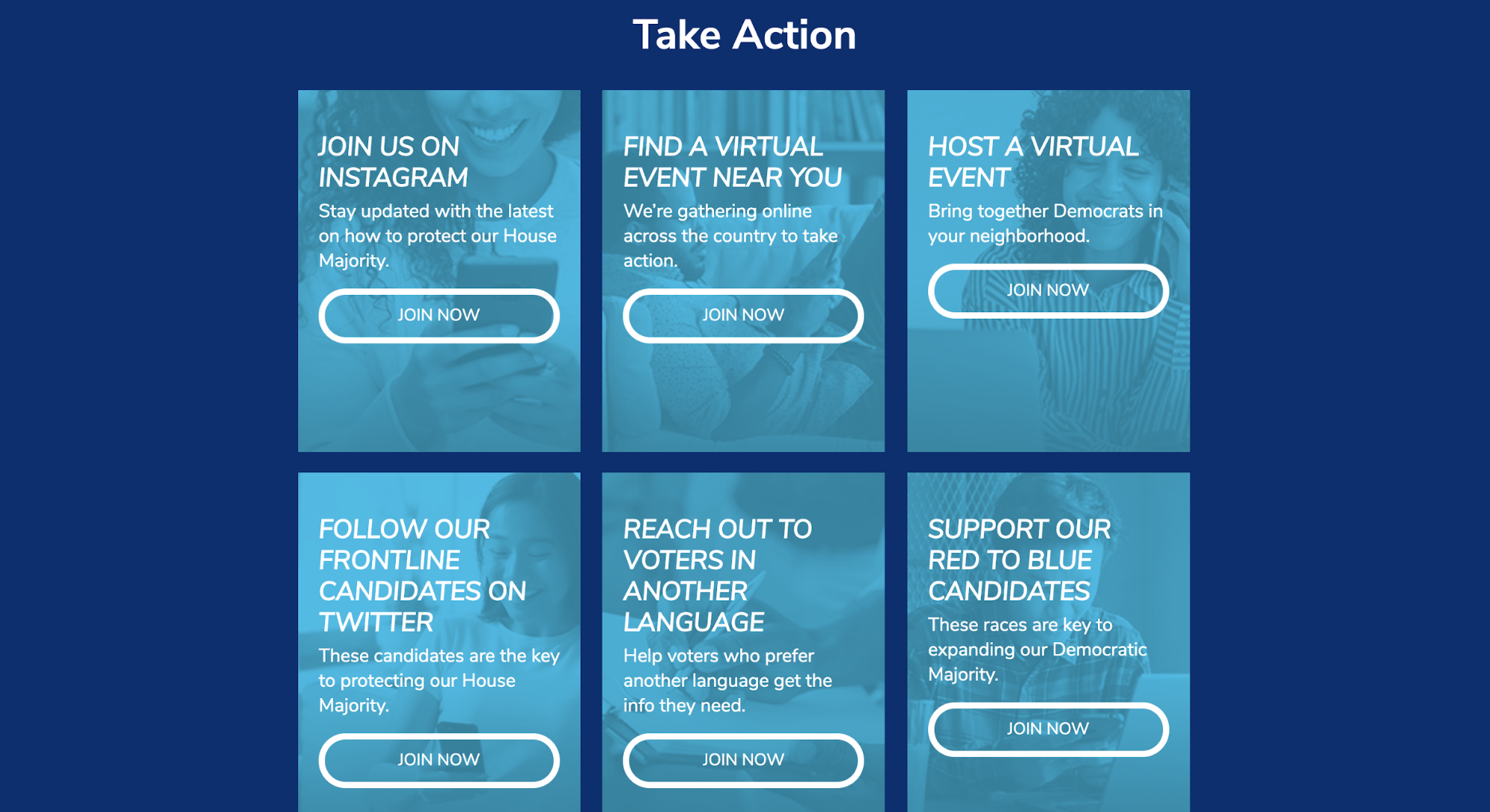

Virtual Action Center by DCCC
DCCC launched a virtual action center to engage new supporters in the digital space. Interested volunteers have an array of actions they can take on the action center, from following DCCC on social media to phone banking or hosting their own event. DCCC’s goal? To “enlist an online volunteer army”. This goes back to the previous tactic of allowing supporters more flexibility in how they can engage with your campaign.
Engaging supporters for long term retention
Once you bring folks into the fold of the campaign, different supporters will require different levels of engagement.
That supporter who signed up for a phone banking shift? Follow-up with an asks to commit to two shifts every week. First-time event attendee? Invite to a weekly town hall.
For committed volunteers who you’re trying to move up the ladder of engagement, phone calls are going to help you have more effective and persuasive conversions. People can be mean over a text, but when folks are listening to you talk, they’re actively engaged and you stand a higher chance of getting them to take higher-barrier actions.
Once they’re committed, SMS texts are a personal, quick, and non-intrusive way to get confirmation before the shift.
‘“Hey James, just want to make sure you have the Zoom link for the 5 pm shift. 😀”
How to keep phone and text banking volunteers engaged
- Make volunteer training part of your onboarding for new volunteers. When Sierra Club looked at data on their volunteers they found that only 2% of volunteers were below 40 years of age. Keep in mind that your volunteers may not be well versed in technical tools. You can start with anything from a simple guide and agent onboarding video like this one from Democrats Abroad to a full-fledged Organizing Bootcamp. The Bernie campaign even had a Teachable course for text bankers.
- Make sure volunteers have access to help and a community at all times either through a Slack channel (like Sierra Club has) where they can interact with other volunteers or through a point of contact at the campaign. Volunteers working remotely don’t have the luxury of leaning over to a nearby volunteer to ask for help.
- Create a sense of community by hosting virtual phone banking parties. Volunteers can join in over a Zoom call and spend a few minutes getting to know each other before and after the phone banking shift. You can also mix things up by inviting special guests to phone bank with your volunteers. Along with increased engagement, the Warren campaign also saw a spike in registrations when they sent out an invite announcing that campaign manager, Roger Lau would be joining the phone bank.
- Give volunteers the flexibility to choose the hours they can phone the bank remotely. Democrats Abroad had live campaigns running across multiple states in CallHub. A volunteer could log in to their account when they had spare time, see a list of live campaigns, and join anyone that interested them and start making calls. Read the full story of how Democrats Abroad managed their distributed phone banking efforts.
- For a lot of folks, their normal work schedule is pretty weird right now. Your volunteers are going to get a lot of people telling them “Oh now’s not a good time”. Let them know to keep their spirits up and note down a suitable time that works for the person. In CallHub, the volunteer can schedule a follow-up call that’s more convenient for the contact and the dialer will automatically connect your volunteer to the contact at the scheduled time.
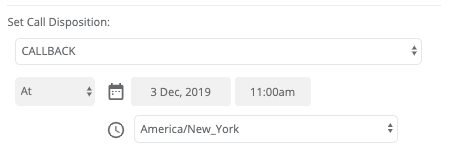

For others who might be too busy to volunteer their time to a phone or text bank, use frequent events to keep them engaged.
David Carlucci, the state Senator from Rockland County hosts two Facebook live sessions every week. A virtual town hall of sorts. He even has special guests join him to talk about relevant issues.
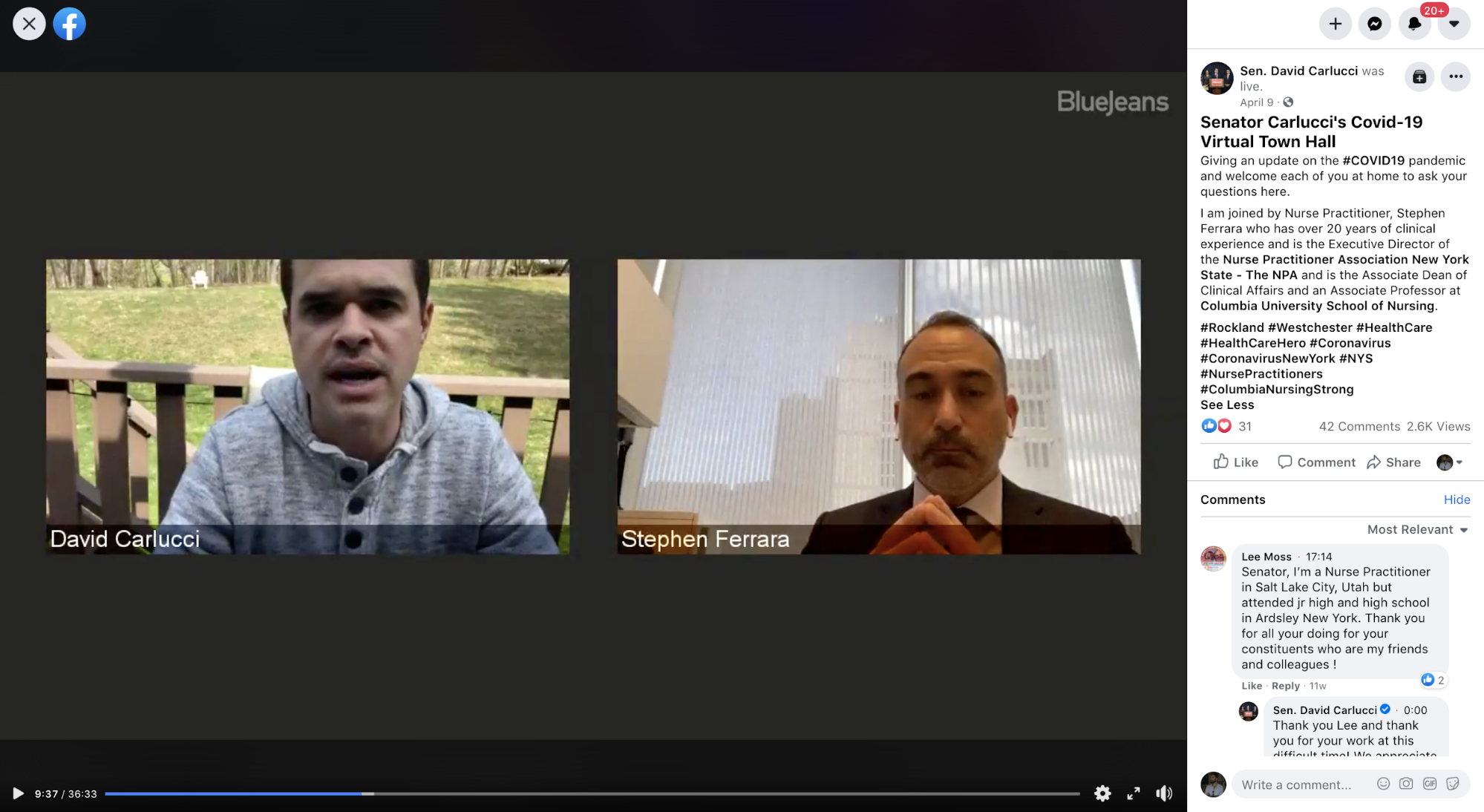

Source: David Carlucci on Facebook
For live events, check out tools like Icebreaker for community-building and Streamlabs for streaming across multiple platforms.
If you don’t have the capacity for events or a weekly town hall try other creative approaches like the students from American University did.
American University students passed around digital flyers to motivate students to urge the university to divest from fossil fuels. Each member sent out flyers to at least five of their contacts to educate them about the student body vote. Each contact was then nudged to spread the word on social media, through texts and direct messages.
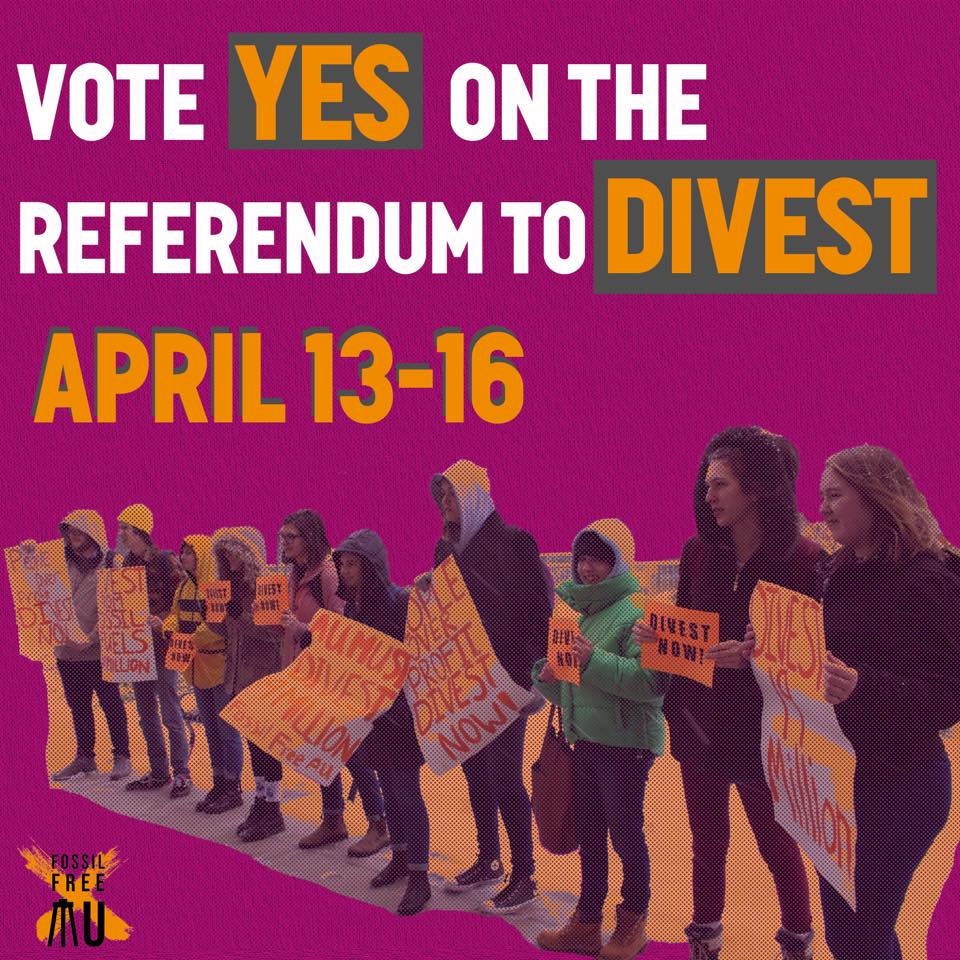

Your engagement tactic could be a weekly live stream over Facebook, an engaging flyer, an occasional personalized email, or any of the hundreds of ideas from the Mobilize events page. But keep the relationship alive.


Related watch: Robin Curran, Digital Fundraising Director for Bernie 2020 talks about the impact personalized emails had for the campaign.
Related reading: How 350.org kept supporters engaged with text conversations, petitions and art builds before they were activated to participate in a rally.


Activating supporters to become stakeholders
Supporters who’ve regularly been engaging with you can be activated to take slightly more difficult actions that bring more people into the fold of the campaign or take up opportunities that create a larger impact. These are actions that have a direct impact on the ballot.
Use relational organizing to engage contact circles of supporters
For most folks, that could be in the form of a relational organizing app that they download to share regular updates with friends and family.
Apps like Team, OutreachCircle, and Outvote let folks map their contact list to the voter list of that constituency to identify friends and family members in the electorate who are registered to vote. Templated text messages and social media updates make it easy for supporters to personalize them and quickly share them within their network.
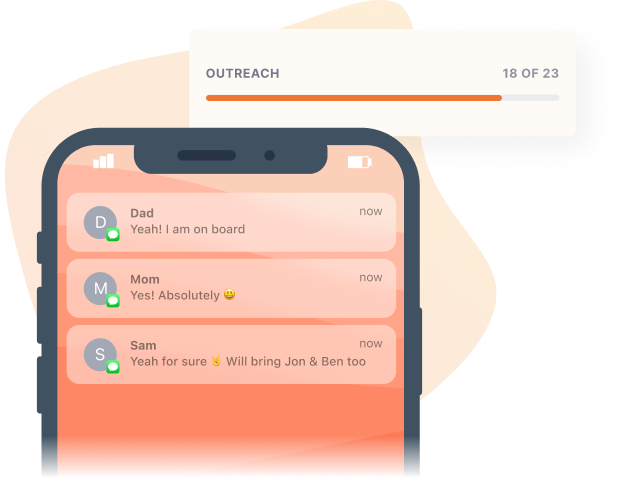

| Ready to revolutionize the way you organize online? See how Relational Organizing will help you build real connections and drive results. |
Tip: Ask volunteers before and after a shift to reach out to 5 contacts and ask them to register to vote, share an update on social media, call a member of congress, become a volunteer or get out the vote. Volunteers are more likely to take action as part of a group than on their own much later. And contacts are more likely to follow through on a request from someone they know than a stranger.
Lead up to a fundraising ask
While fundraising happens across the ladder of engagement, it’s still a high-barrier ask that requires folks to actively support your campaign. And in most races, winning or losing comes down to how much money you have in the campaign coffer.
The ladder of engagement applies to your fundraising tactics as well.
- Bernie’s campaign saw an increase in donations when they made the ask right after a supporter pledged to vote for the candidate. The campaign sent out emails to supporters asking them to fill out a form to pledge support. On submit, the form redirected them to a donation page.
- Mobilize found that 17% of supporters initiate a donation when asked after they sign up for a shift.
This approach can be used across multiple modes of engagement. If you are collecting signatures for a petition, make your fundraising ask right after a supporter submits it. The initial effort to support the campaign makes people more invested and likelier to take further actions to help out.
Fundraising tip: Supporters increasingly look for information about a campaign on your website. The 2020 M+R Benchmarks Study found that 44% of visits to nonprofit websites consisted of organic (unpaid) traffic. But only 0.17% of those visitors made a donation. Start building relationships with visitors from the moment they land on your site. And use the ladder of engagement to multiply your asks. Anedot found that almost 25% of donors took additional action to make the donations recurring or give to a similar organization when asked after their initial donation.
Related reading:
Political Fundraising- definition, strategy, and tools to bring in the $$$
Maximize volunteer recruitment through network effects


Network effects play a crucial role in getting you more phone and text banking volunteers. Mobilize found that organizations signing up with them saw a 38% uptick in shifts primarily owing to their large network of volunteers and the ease of discoverability for events from different organizations. Every time a volunteer signs up for a shift, the platform shows them similar events that might interest them. You also have the ability to co-host events with partner organizations so that each of your events is visible in each other’s timelines.
For volunteers who’ve consistently taken upshifts, ask them to help with volunteer training, and gradually move them to lead their own training efforts.
Tip: Get on more frequent calls with your volunteer leaders. Hopping on quick calls to discuss ideas makes folks more invested and active stakeholders in your campaign.
Related reading:
How to plan a virtual event (with examples)
Final thoughts
A cookie-cutter approach doesn’t work in the virtual world.
The Bernie campaign gamified their virtual events.
Congressional candidate Allison Fine sent out weekly newsletters that looked like they were written on a Smith Corona Typewriter to make them personal.
Most campaigns halted regular campaign operations during the pandemic to focus on community check-in calls to make sure people are all right.
Digital organizing technology can lend itself to different uses. But most importantly, they reduce the barrier to thinking creatively. These strategies might work for you or it might be a different tactic that hits the mark.
Can’t go door-to-door? Use the turf-cutting feature in MiniVAN to create phone banking lists for your neighborhood. People not picking up the phone? Follow up with a text message letting them know why you called.
If you can keep your communication mostly empathetic, sometimes funny, and always relevant to the current situation, people are going to want to listen. Back that up with the right digital organizing strategy and you have a recipe for success.
Go forth and conquer organize.
“Go forth and conquer
for the world is small
and you are the giant
and in every step
you take will make the ground shake
as it rises
to meet you”
— Atticus, Anonymous Instagram poet
Did you try any creative organizing tactics? How’d that work out? Share your experience in the comments section or shoot me a mail at [email protected].
Appreciation:
We’re deeply grateful to the teams at ANOTHERACRONYM, Blueprints for Change, Mobilize, MobLab, Higher Ground Labs, and M+R for creating content that inspires folks to think strategically about bringing power to the people.


